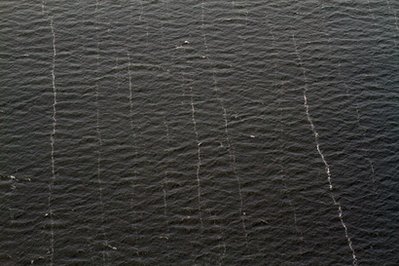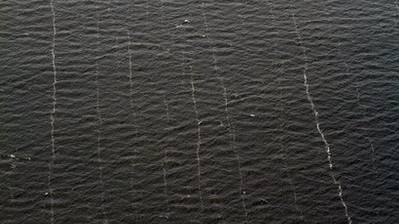Long Lost Oil Found in form of 22 mile long underwater plume
Source: news.yahoo.com
A 22-mile-long invisible mist of oil is meandering far below the surface of the Gulf of Mexico, where it will probably loiter for months or more, scientists reported Thursday in the first conclusive evidence of an underwater plume from the BP spill.The most worrisome part is the slow pace at which the oil is breaking down in the cold, 40-degree water, making it a long-lasting but unseen threat to vulnerable marine life, experts said.
Earlier this month, top federal officials declared the oil in the spill was mostly "gone," and it is gone in the sense you can’t see it. But the chemical ingredients of the oil persist more than a half-mile beneath the surface, researchers found.

In this Aug. 16,2010 file photo, faint streaks of weathered oil are seen on the Gulf of Mexico near the coast of Louisiana. Scientist studying the gulf oil spill differ on the amount of oil that was spilled into the Gulf of Mexico from the BP Deepwater Horizon rig, how much remains in the water and the long term effect on the environment. (AP Photo/Patrick Semansky)
And the oil is degrading at one-tenth the pace at which it breaks down at the surface. That means "the plumes could stick around for quite a while," said study co-author Ben Van Mooy of the Woods Hole Oceanographic Institution in Massachusetts, which led the research published online in the journal Science.
Monty Graham, a scientist at the Dauphin Island Sea Lab in Alabama who was not involved in the study, said: "We absolutely should be concerned that this material is drifting around for who knows how long. They say months in the (research) paper, but more likely we’ll be able to track this stuff for years."
Late Thursday, federal officials acknowledged the deepwater oil was not degrading as fast as they initially thought, but still was breaking down "relatively rapidly." Jane Lubchenco, chief of the National Oceanic and Atmospheric Administration, said agency scientists and others were "working furiously" to come up with actual rates of bio-degradation.
She noted a bright spot from the slow breakdown of the oil: Faster would mean a big influx of oil-eating microbes. Though they are useful, they also use up oxygen, creating "dead zones" that already plague the Gulf in the summer. Dead zones are not forming because of the oil plume, Lubchenco said.
The underwater oil was measured close to BP’s blown-out well, which is about 40 miles off the Louisiana coast. The plume started three miles from the well and extended more than 20 miles to the southwest. The oil droplets are odorless and too small to be seen by the human eye. If you swam through the plume, you wouldn’t notice it.
"The water samples when we were right in the plume look like spring water," study chief author Richard Camilli said. "You certainly didn’t see any oil droplets and you certainly didn’t smell it."
The scientists used complex instruments — including a special underwater mass spectrometer — to detect the chemical signature of the oil that spewed from the BP well after it ruptured April 20. The equipment was carried into the deep by submersible devices.
With more than 57,000 of these measurements, the scientists mapped a huge plume in late June when the well was still leaking. The components of oil were detected in a flow that measured more than a mile wide and more than 650 feet from top to bottom.
Underwater plumes several miles across have been spotted since at least May, as shown on this diagram from the Rachel Maddow Show on msnbc-tv from May 27, 2010
Federal officials said there are signs that the plume has started to break into smaller ones since the Woods Hole research cruise ended. But scientists said that wouldn’t lessen the overall harm from the oil.
The oil is at depths of 3,000 to 4,000 feet, far below the environment of the most popular Gulf fish like red snapper, tuna and mackerel. But it is not harmless. These depths are where small fish and crustaceans live. And one of the biggest migrations on Earth involves small fish that go from deep water to more shallow areas, taking nutrients from the ocean depths up to the large fish and mammals.
Those smaller creatures could be harmed by going through the oil, said Larry McKinney, director of Texas A&M University’s Gulf of Mexico research center in Corpus Christi.
Some aspects of that region are so little known that "we might lose species that we don’t know now exist," said Graham of the Dauphin Island lab.
"This is a highly sensitive ecosystem," agreed Steve Murawski, chief fisheries scientist for the federal agency NOAA. "The animals down at 3,300 to 3,400 feet grow slowly." The oil not only has toxic components but could cause genetic problems even at low concentrations, he said.
Lubchenco said NOAA is "very concerned about the impact" of the oil below the surface and federal officials last week started more aggressive monitoring of it.
For much of the summer, the mere existence of underwater plumes of oil was the subject of a debate that at times pitted outside scientists against federal officials who downplayed the idea of plumes of trapped oil. Now federal officials say as much as 42 million gallons of oil may be lurking below the surface in amounts that are much smaller than the width of a human hair.
While federal officials prefer to describe the lurking oil as "an ephemeral cloud," the Woods Hole scientists use the word "plume" repeatedly.
The study conclusively shows that a plume exists, that it came from the BP well and that it probably never got close to the surface of the Gulf of Mexico, Camilli said. It is probably even larger than 22 miles long, but scientists had to stop measuring because of Hurricane Alex.
Earlier this week a University of South Florida team reported oil in amounts that were toxic to critical plant plankton deep underwater, but the crude was not necessarily in plumes. Those findings have not been reviewed by other scientists or published.
The plume is probably still around, but moving west-southwest of the BP well site at about 4 miles a day, Camilli said.
While praising the study that ended on June 28, Murawski said more recent observations show that the cloud of oil has "broken apart into a bunch of very small features, some them much farther away." Texas A&M’s McKinney said marine life can suffer harm whether it is several smaller plumes or one giant one.
NOAA redirected much of its sampling for underwater oil after consulting with Woods Hole researchers. The federal agency is now using the techniques that the team pioneered with a robotic sub and an underwater mass spectrometer, Murawski said.
Previous attempts to define the plume were "like watching the Super Bowl on a 12-inch black-and-white TV and we try to bring to the table a 36-inch HD TV," said Woods Hole scientist Chris Reddy. The paper, fast-tracked for the world of peer-reviewed science, was written on a boat while still in the Gulf, he said.
Reddy said he could not yet explain why the underwater plume formed at that depth. But other experts point to three factors: cold water, the way the oil spewed from the broken well, and the use of massive amounts of dispersants to break up the oil before it gets to the surface.
Read the full article at: news.yahoo.com
The Energy Report - 8/19/10
Video from: YouTube.com






















